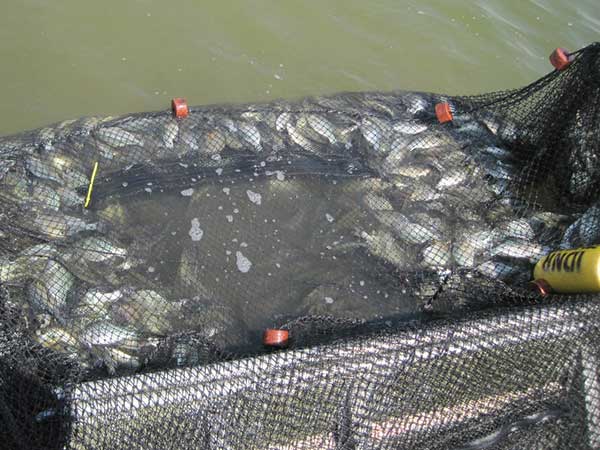(Provided by Indiana DNR)
 DNR studies crappie populations in northern Indiana.
DNR studies crappie populations in northern Indiana.
Catching nearly 5,000 black crappies in one day at Shipshewana Lake might be an angler's dream, but for Steve Donabauer the catch was nearly a nightmare.
Donabauer, a DNR fisheries biologist, caught them in late April in two trap nets as part of a region-wide study of crappie numbers and sizes. Most were small. Where crappies are over-populated, competition for food can be intense.
The first-of-its-kind study will help DNR biologists understand crappie populations in northern Indiana's glacial lakes. Previous information on crappies has been limited because they are difficult to catch in standard fish-population surveys.
"We bought some newly designed trap nets that can target crappies, especially in the spring," Donabauer said. "The huge catch at Shipshewana Lake obviously proved they work."
The traps worked so well that Donabauer removed them after the first day. Enough was enough.
After measuring hundreds of crappies and figuring how many could fill a 5-gallon bucket, Donabauer and assistant biologist Bri Ciara had to resort to counting them by the bucketful before releasing them back to the lake.
In addition to Shipshewana Lake in LaGrange County, DNR biologists sampled seven other lakes. They were Simonton Lake in Elkhart County, North Twin Lake in LaGrange County, Hudson Lake in LaPorte County, Mill Pond in Marshall County, Big and Skinner lakes in Noble County, and Lake Gage in Steuben County.
Of the eight lakes, Skinner Lake ranked second behind Shipshewana with 1,889 black crappies. Another 94 white crappies also were trapped.
"The biggest crappie we caught at Shipshewana was only 9 inches long," Donabauer said. "At Skinner, only 23 crappies were 10 inches or bigger."
In contrast, 146 crappies were trapped up to 13 inches long at Mill Pond. Hudson Lake produced 84 crappies up to 12 inches with nearly half more than 10 inches. At Big Lake, 74 crappies were caught and nearly all were 10 inches or larger.
North Twin Lake provided only four crappies. None were captured at Lake Gage.
"These numbers show the wide range we have in crappie populations and crappie sizes," Donabauer said. "Not all lakes are the same and as we learn more about them we should be in a better position to manage them."


